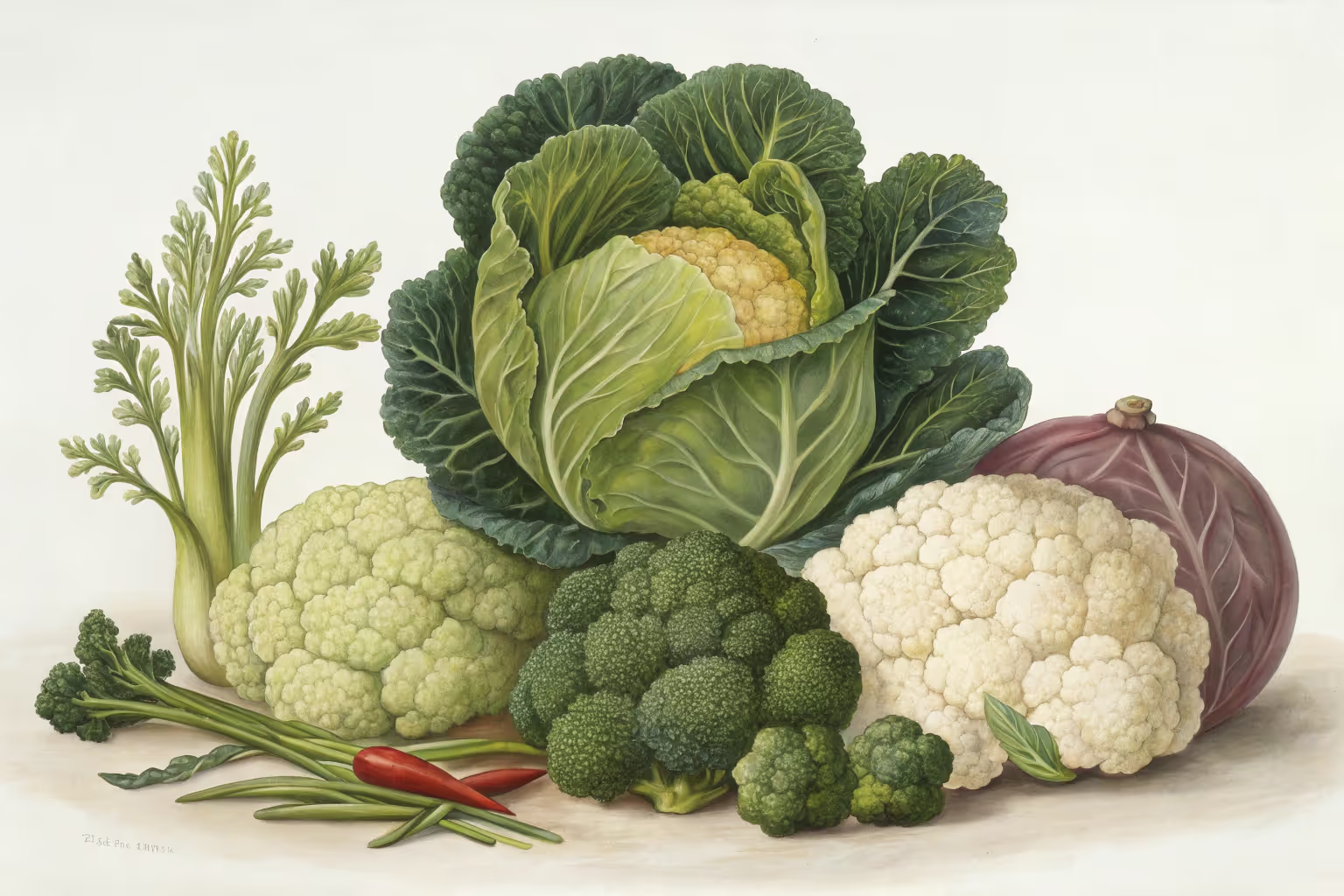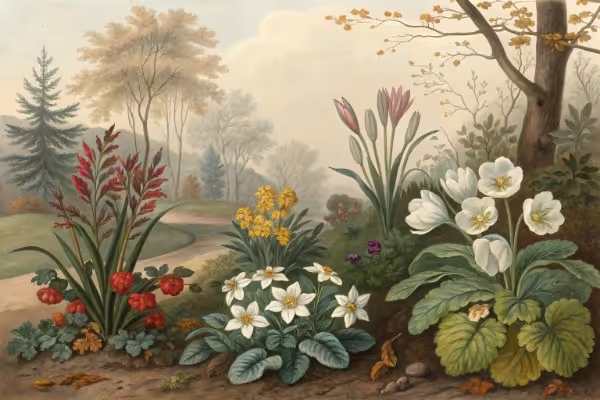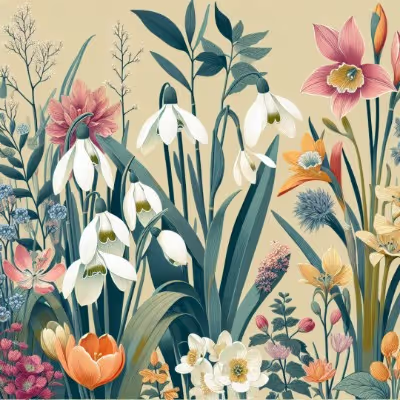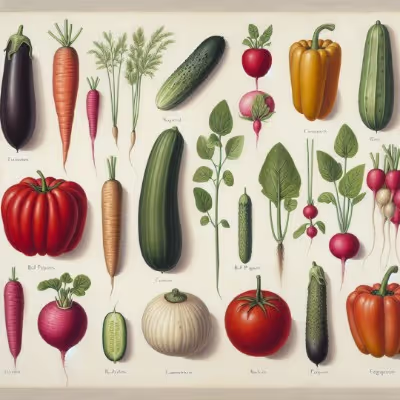Cruciferous Vegetables: A Gardener's Essential Handbook

Cruciferous Vegetables
Planting cruciferous vegetables packs your garden beds with nutrient-dense crops, from peppery arugula and crispy kale to vibrant broccoli and cauliflower. These leafy brassicas enrich your soil, combat pests naturally, and thrive in cool growing conditions. Grow cruciferous vegetables successfully, and you'll harvest vitamin-packed, delicious produce—keep reading for expert planting tips, proven companion pairings, and savory garden-to-table ideas.
Cheatsheet: Master Growing Brassicas
🥦 Family Highlights
- Includes: Broccoli, cabbage, kale, cauliflower, Brussels sprouts, kohlrabi, arugula, radish
- Cool-season: Sow early spring or late summer
- Contain glucosinolates: Disease-fighting plant compounds
- Daily intake linked to 25% lower cancer risk
🌱 Sowing & Spacing
- Soil: Rich, well-drained, pH 6.0–7.0
- Temp: 50–75°F (10–24°C)
- Direct sow or transplant after frost
- Spacing: 12–24 in (30–60 cm) apart, rows 18–36 in (46–91 cm)
💧 Water & Feeding
- 1–1.5 in (2.5–4 cm) water/week
- Mulch to retain moisture, suppress weeds
- Feed with nitrogen-rich compost or organic fertilizer
🐛 Pest & Disease Defense
- Netting deters cabbage moths
- Rotate crops yearly
- Use neem oil or hand-pick caterpillars
- Watch for clubroot, black rot
🌡️ Harvest & Storage
- Harvest when heads firm or roots fill out
- Pick leaves young for tenderness
- Store: 32–40°F (0–4°C), up to 4 weeks
🛠️ Tools and Products You'll Need
- Hand trowel, hoe
- Row covers or netting
- Organic fertilizer
- Mulch
- Soil pH test kit
🥗 Health & Self-Sufficiency
- Rich in vitamin C, K, fiber, folate
- Supports gut, immune, brain health
- Yields year-round with succession planting
Prepare soil: Add compost, check pH, rake smooth.
Sow seeds or transplant: Follow spacing, water well.
Feed & mulch: Apply fertilizer, mulch base.
Protect crop: Install netting, check for pests weekly.
Harvest: Cut heads or pick leaves, refrigerate promptly.
- Seeds or seedlings
- Compost
- Organic mulch
- Netting or row cover
-
Cruciferous Vegetables: A Gardener's Essential Handbook
I grow brassicas like rent money depends on them, because in cool months they carry the kitchen and the soil both. I prize their bite, the way a frost flips starch to sugar and a pan flip with garlic turns a harvest into silence at the table.
Brassicaceae, flavor chemistry, and why your soil matters
Cruciferous Vegetables are the mustard family, so think broccoli, cabbage, kale, cauliflower, Brussels sprouts, bok choy, turnip, kohlrabi, arugula, radish, and mustard greens. Their signature tang comes from sulfur compounds called glucosinolates that break into isothiocyanates when chopped and chewed.
That release needs the enzyme myrosinase, which soft cooking can disable. I steam short, then finish in a hot pan, so flavor stays vivid and the kitchen smells like I mean business.
“Light steaming preserves myrosinase activity, while prolonged high heat reduces it,” report researchers summarizing brassica prep best practices. Source: Oregon State University, Linus Pauling Institute, and Johns Hopkins brassica research.
Timing is everything, and the calendar is a blade
These are cool-season crops, happiest at 60 to 70 F, which is 15 to 21 C. I seed early spring and again for fall, because summer heat above 80 F, or 27 C, triggers bitterness, loose heads, and bolting.
One August, a hot wind turned my cauliflower to rice in two days. Shade cloth at 30 percent and a deeper mulch rescued the second sowing.
Soil prep, fertility, and the sulfur lever
I shoot for pH 6.5 to 7.2 and add two to three inches, or 5 to 8 cm, of compost before planting. Consistent moisture matters, about 1 to 1.5 inches per week, or 25 to 38 mm, delivered by drip to keep leaves dry.
Sulfur in the soil nudges pungency and glucosinolate levels, which sharpens flavor. If a bed tastes flat year after year, a soil test often shows low sulfur or organic matter, so I amend with composted manure or gypsum if I also need calcium.
Varieties that earn their keep
- Broccoli De Cicco, early and cut and come again, 18 inch spacing, or 45 cm. Arcadia handles heat better, side shoots for weeks.
- Cauliflower Snow Crown for reliability, Cheddar for orange curds that stay firm. Tie leaves or use self-blanching types to keep heads white.
- Brussels sprouts Dagan or Gustus, tall, straight stalks, 24 inch spacing, or 60 cm. Top plants in late summer to size up sprouts evenly.
- Kale Lacinato for texture, Red Russian for speed, Winterbor for deep cold. Flavor spikes after a hard frost.
- Cabbage Tendersweet for slaw, January King for winter harvest, and Storage No. 4 for keeping. I give heads 18 inches, or 45 cm, to breathe.
- Asian greens Joi Choi, Tatsoi, and Mizuna, ready in 21 to 40 days. Succession plant every 10 to 14 days.
- Kohlrabi Kossak for giant bulbs that stay tender. Crisp like an apple, eats like a vegetable oyster.
- Radish and turnip Daikon breaks compaction, Hakurei turnips are sweet raw. I use daikon as a biodrill before spring brassicas.
Planting plan and spacing that saves headaches
I transplant heading crops for an even stand, but I direct sow roots and fast greens. Broccoli, cauliflower, and cabbage transplant best at 4 to 6 true leaves, stocky and not rootbound.
My spacings are simple, measured by hand length in the field. Broccoli 18 inches, cabbage 18 inches, Brussels 24 inches, kale 12 to 18 inches, and cauliflower 18 inches, or 30 to 60 cm in metric.
Pest and disease playbook that actually works
I start with insect netting or light row cover from day one, 0.8 mm mesh keeps moths out. Then I scout weekly, because early intervention beats spraying later.
- Chewers Imported cabbageworm, cabbage looper, diamondback moth. Bacillus thuringiensis var. kurstaki targets caterpillars, and spinosad is a backup, always with label care. Flower strips of sweet alyssum and dill pull in parasitic wasps that clean up eggs and small larvae, as promoted by UC IPM and Michigan State trials.
- Flea beetles I plant a sacrificial row of radish or arugula as a trap, then net the cash crop. On seedlings, neem in the evening helps until plants outgrow damage.
- Aphids A hard water blast knocks most off, then lady beetles and lacewings finish the job. Overhead irrigation in the morning can break cycles, if disease pressure is low.
- Clubroot Plasmodiophora brassicae lurks for years, so rotate three to four years out of brassicas. Lime to pH above 7.2 where clubroot is known, a classic recommendation from University of Wisconsin Extension.
- Black rot Start with clean seed or hot water seed treatment per extension temperature and time charts. Avoid overhead irrigation late in the day, and rogue out any V-shaped leaf lesions fast.
- Slugs and snails Night patrol with a headlamp teaches you a lot. Iron phosphate baits and copper tape around seedling flats save transplants.
Water, stress, and flavor management
Uneven moisture cracks cabbage and turns radish spicy in a bad way. I mulch with clean straw, then side-dress nitrogen lightly when broccoli heads start to size, a move that extends side shoots.
After the first freeze, kale sweetens, the shift is real. Sap brix jumps, which you can read on a cheap refractometer if you like measuring your smiles.
Harvest and storage like a pro
I cut broccoli when beads are tight and dark, then keep plants for weeks of side shoots. Cauliflower harvests just as heads firm, and I chill immediately to hold texture.
Cold and wet is the rule, 32 F at 95 percent relative humidity, or 0 C near saturated air. UC Davis Postharvest Center guidance aligns with what my cooler proves every season.
One cup of raw broccoli supplies well over half the daily vitamin C target, with fiber and vitamin K riding shotgun. Source: USDA FoodData Central and Harvard T. H. Chan School of Public Health.
Kitchen moves, nutrition, and preserving
I steam for 3 to 5 minutes, then hit the pan with olive oil, garlic, lemon, and a little chile. Acid and fat tame bitterness and make Tuesday taste like a holiday.
Broccoli sprouts and microgreens carry concentrated glucoraphanin, as Johns Hopkins researchers have documented for years. Sauerkraut and kimchi bank cabbage for winter and add lactic acid bacteria that play well with a steady diet.
Cover crops, biofumigation, and rotation
Mustard cover crops chopped at peak bloom and tilled moist release sharp compounds that can suppress some soil pests. Washington State University trials outline the timing, and I treat it as one tool among many, never a silver bullet.
I never follow brassica with brassica, even if the bed looks clean. A four-year rotation out keeps diseases sleepy and my future self thankful.
Buyer’s guide, practical and to the point
- Seeds Choose bolt tolerant and disease tolerant lines, look for black rot tolerance in catalog notes. Untreated seed for organic starts, or primed seed for tricky spring windows.
- Starts Pick short, dark transplants with no yellowing and no circling roots. Four to six true leaves is the sweet spot.
- Row cover and netting Spunbond at 0.5 oz per square yard shields down to about 28 F, or minus 2 C. Insect netting at fine mesh blocks moths without trapping heat in summer.
- Fertility Baseline compost, then side-dress with a gentle nitrogen source at heading. Calcium nitrate can correct tip burn in fast-growing cauliflower, if a soil test shows need.
- Soil tests and amendments Keep a pH kit handy, and know your lime, calcitic for calcium, dolomitic for magnesium. Gypsum adds calcium without raising pH, handy for clubroot-prone beds managed at higher pH.
- Shade and tunnels Thirty percent shade cloth saves spring and fall transplants in surprise heat. Low tunnels with hoops and clips pay for themselves in caterpillar pressure alone.
Seasonal cheat sheet
- Late winter to early spring, start broccoli and cabbage indoors, direct sow radish and arugula under cover. Transplant as soon as soil works, which is when a squeezed handful crumbles.
- Late spring, watch for bolting on Asian greens, install shade cloth before a heat spike. Harvest tight and often, then replant the gaps.
- Mid to late summer, seed fall broccoli and cabbage under netting. Keep beds damp and cool with mulch and evening irrigation.
- Fall, plant garlic where brassicas grew and move brassicas to a fresh bed. Enjoy frost-sweetened kale, sprouts, and storage cabbages.
- Winter, keep low tunnels vented on sunny days. Harvest Brussels after a freeze for the best pan-roast of the year.
Curated sources I actually use
- UC IPM and UC Davis Postharvest Technology Center, for pest ID and storage science.
- Oregon State University Linus Pauling Institute and Johns Hopkins Brassica research, for glucosinolate and sulforaphane science.
- University of Wisconsin Extension, Penn State Extension, and Royal Horticultural Society, for clubroot, rotation, and cultural controls.
- USDA FoodData Central and Harvard T. H. Chan School of Public Health, for nutrition baselines and clear dietary context.
- FAO and national extension bulletins, for production trends and climate timing tips.
I have learned these crops reward steady habits and quick hands. Grow them with nerve and patience, and the garden will teach you the rest.

Want smarter plant choices? 🪴
Frequently Asked Questions About Growing Cruciferous Vegetables
How do I prep the soil properly for cruciferous vegetables?
These hearty vegetables thrive in soil rich with organic matter. Work in compost or aged manure to create a fertile, moisture-retaining environment. The earth should drain freely but never parch easily—think loamy, dark, and alive.
What are the best planting companions for cruciferous crops?
Cruciferous varieties pair beautifully alongside herbs like dill and rosemary, which subtly repel pests. Interplanting with onions or marigolds helps confuse the cabbage moth and aphid invaders, creating an aromatic shield around your brassicas.
How often should cruciferous vegetables be watered?
Consistency rules the watering schedule. Aim for deep, thorough watering—once or twice weekly depending on weather conditions—allowing moisture to sink profoundly into the root zone. Avoid shallow sips that tease rather than nourish.
What's the ideal time to plant cruciferous vegetables?
These confident crops favor cool weather. Begin planting early spring for a vigorous head start, or enjoy a second round with late summer planting for a flavorful autumn harvest. Respect their cool-season nature to savor peak flavor and robust growth.
How can pests be prevented naturally?
Practice vigilant crop rotation, companion planting, and encourage beneficial insects like ladybugs and lacewing. Floating row covers act as a sturdy physical barrier—think proactive rather than reactive—to pests such as aphids and cabbage worms.
Can cruciferous vegetables be grown in containers?
Container gardening grants freedom, and these veggies grow admirably in pots. Offer containers at least 12 inches deep filled with rich, well-draining soil mix. Ensure sufficient moisture and nutrients, and place them in spots kissed generously by sunlight.
How do I identify and manage common cruciferous diseases?
Stay alert to diseases like clubroot or powdery mildew. Rotate your crops annually, ensure breathable plant spacing, remove affected foliage promptly, and maintain disciplined cleanliness in your garden to outmaneuver potential infections.
What's the secret to harvesting cruciferous vegetables at peak flavor?
Harvest early mornings after dew lifts, while plants brim with crispness and flavor potential. For broccoli and cauliflower, cut heads firm and tight. With kale, collards, and bok choy, pick younger leaves tender and vibrant, leaving plants invigorated to produce again.
Cruciferous Vegetables reward patient hands and sharp eyes. Year after year, these staples—broccoli, cabbage, kale, and their kin—bring both grit and grace to any bed. They thrive with decent soil, steady moisture, and a little defense from pests, but don’t demand perfection. If you’re after nutrient-dense vegetables that pull double duty—feeding your body and your sense of accomplishment—they’re tough to beat.
Rotate crops, give them sun, and mind your spacing. Try your hand at companion planting for healthier harvests. There’s satisfaction in pulling a head of homegrown cauliflower or a fistful of peppery arugula from your own patch. If you want a garden that’s both productive and practical, cruciferous vegetables should be a fixture in your rotation. They’re nothing fancy, just honest, reliable, and good for you—season after season.
Health Benefits You Didn't Know About Cruciferous Vegetables
Anti-Cancer Properties
- Contain sulforaphane, shown to limit growth of cancer cells and activate detoxification enzymes.
- Broccoli sprouts have up to 50 times more sulforaphane concentration than mature broccoli.
Natural Gut Boosters
- Provide unique dietary fiber that feeds beneficial gut bacteria, improving digestion.
- Fermented cabbage (Sauerkraut, Kimchi) supports gut flora, immunity, and nutrient absorption.
Hormonal Health Support
- Contain Indole-3-Carbinol (I3C) aiding balanced estrogen metabolism, useful for hormonal health.
- Regular intake may mitigate symptoms related to estrogen imbalance.
Bone Strength and Joint Health
- Rich in calcium, vitamin K, magnesium enhancing calcium absorption and bone integrity.
- Collard greens provide 232 mg calcium per 100g, comparable to dairy products.
Optimizing Nutrient Retention
- Steam or lightly sauté vegetables at low heat (below 140°F/60°C) no longer than 4-5 minutes to preserve glucosinolates and sulforaphane.
- Pair with mustard seeds or radish to boost enzyme activity and enhance nutrient absorption.
Find out which plants will thrive in your garden!
Answer a few fun questions and get custom plant recommendations perfect for your space. Let’s grow something amazing together!

start your season





